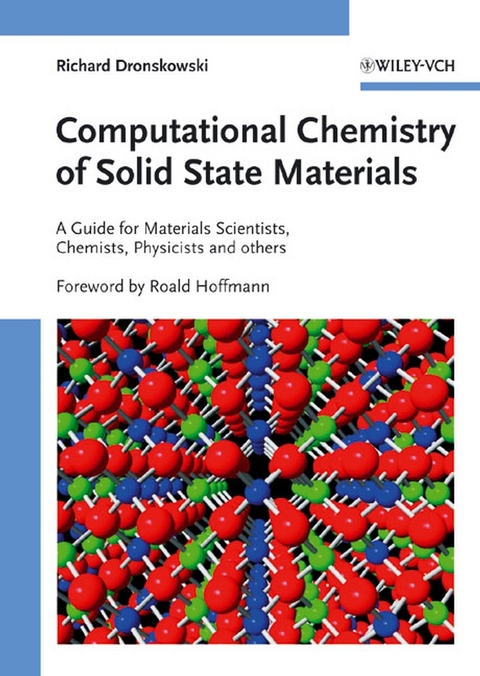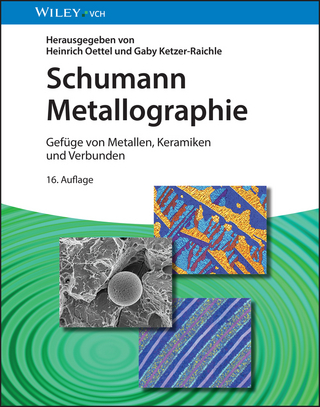
Computational Chemistry of Solid State Materials
Wiley-VCH (Verlag)
9783527314102 (ISBN)
- Titel ist leider vergriffen;
keine Neuauflage - Artikel merken
Describing solid state materials with computational and theoretical models is now an important tool for solid state chemists, making it possible to gain an insight into electronic and magnetic structure, as well as chemical bonding. In addition, chemists are now able to make a prediction about materials that are yet to be synthesized, such that a systematic and successful synthesis of new materials with specific properties and attributes is possible.
This is the first book to present both classical practical approaches as well as practical quantum-chemical approaches, incorporating the many new methods developed over the last few years. Written especially for "non"-theoretical readers in a very comprehensible and readily implemental style, it includes numerous practical examples of varying degrees of difficulty. Similarly, the use of mathematical equations is reduced to a minimum, focusing only on that which is important for experimentalists. Backed by many extensive tables containing detailed data for direct use in the calculations, this is the ideal companion for theoretical and solid state chemists, physicochemists, crystallographers and materials scientists, wishing to improve their work in solid state research by using computational methods.
Richard Dronskowski studied chemistry and physics at Münster University and gained his PhD from the Max Planck Institute for Solid State Research in Stuttgart. After one year as a Visiting Scientist at Cornell University and completing his lecturing qualification in 1995, he took up the chair of Inorganic and Analytical Chemistry at RWTH Aachen University in 1997, as head of its Institute of Inorganic Chemistry. He has won the Kekulé and Liebig scholarships, the Otto Hahn medal awarded by the Max Planck Society, and the Chemistry Lecturer prize. In 2004, he became Visiting Professor at the Center of Interdisciplinary Research at Tohoku University, Sendai. Professor Dronskowski's research interests originate in the area of "theorimental" solid state chemistry, in particular the design, synthesis and structural as well as quantum-chemical characterization of low-valent, metastable, nitrogen-based, intermetallic and magnetic compounds.
From the Contents:
CLASSICAL APPROACHES
Ionic Radii Concepts
Electrostatics
Pauling´s Rules
Volume Increments
The Bond-Valence Method
Symmetry Principles
QUANTUM-CHEMICAL APPROACHES
Schrödinger´s Equation
Basis Sets for Molecules
Three Myths of Chemical Bonding
Bloch´s Theorem
Reciprocal Space and the k Quantum Number
Band Structure
Density-of-States and Basic Electron Partitioning
Exchange and Correlation
Electron Localization
How to deal with Exchange and Correlation
DFT
Beyond DFT
Absolute Electronegativity and Hardness
Potentials and Basic Sets in Solids
Structure Optimization
Molecular Dynamics
Practical Aspects
Computer Implementations
THE THEORETICAL MACHINERY AT WORK
Structure and Energetics
Structural Alternatives: Transition-Metal Nitrides
Structure and Physical Properties: Cerium Pnictides
Structures by Peiersl Distortions: Tellurium
Itinerant Magnetism: The Transition-Metals
Itinerant Magnetism: Transition Metal Compounds
Atomic Dynamics in Fe:AlN Nanocomposites
Structural versus Electronic Distortions: MnAl
Challenging Theory:Mercury Carbodiimide and Cyanamide
Quasi-Binary Oxynitrides
Into the Valid: The Sn/Zn System
Predicting Oxynitrides: VON and High-Pressure Phases
Predicting Magnetic Cyanamides and Carbodiimides
Predicting Magnetic Nitrides
EPILOGUE
Into the Void: The Sn/Zn System
"...ein hervorragendes Handbuch für Studierende und Forscher, die sich mit Rechenmethoden für Festkörperuntersuchungen beschäftigen. Das Buch ist systematisch geordnet und bietet in verständlicher Weise Einblicke in die erläuterten Techniken...Zu alledem kommt dieses Buch genau zur rechten Zeit, denn da Rechenmethoden immer leichter zugänglich werden, bedarf es einer gründlichen Erläuterung von Stärken und Schwächen der vielfältigen in Gebrauch befindlichen Modelle." Angewandte Chemie
| Erscheint lt. Verlag | 25.11.2005 |
|---|---|
| Vorwort | Roald Hoffmann |
| Sprache | englisch |
| Maße | 170 x 240 mm |
| Gewicht | 700 g |
| Themenwelt | Naturwissenschaften ► Chemie |
| Technik ► Maschinenbau | |
| Schlagworte | Chemie • Chemistry • Computational Chemistry • Computational Chemistry & Molecular Modeling • Computational Chemistry & Molecular Modeling • Computational Chemistry u. Molecular Modeling • Festkörperchemie • Materials Science • Materialwissenschaften • Materialwissenschaften / Theorie, Modellierung u. Simulation • Physikalische Chemie • solid state chemistry • Theory, Modeling & Simulation • Theory, Modeling & Simulation |
| ISBN-13 | 9783527314102 / 9783527314102 |
| Zustand | Neuware |
| Informationen gemäß Produktsicherheitsverordnung (GPSR) | |
| Haben Sie eine Frage zum Produkt? |
aus dem Bereich


